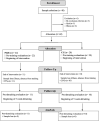Effect of Training and Detraining in the Components of Physical Fitness in People Living With HIV/AIDS
- PMID: 34630129
- PMCID: PMC8493123
- DOI: 10.3389/fphys.2021.586753
Effect of Training and Detraining in the Components of Physical Fitness in People Living With HIV/AIDS
Abstract
The aim of the study was to evaluate the effect of training and detraining on the physical fitness components of people living with HIV/AIDS (PLHA). The study was characterized as experimental with a sample composed of 21 people divided into two groups: 11 volunteers (PLHA, 46.9 ± 8.0 years, 63.8 ± 12.7 kg, 161.7 ± 8.7 cm, 7 men, and 4 women), using antiretroviral therapy (ART) and 10 people without HIV/AIDS in the control group (CG, 43.8 ± 13.8 years, 75.2 ± 11.2 kg, 163.3 ± 7.8 cm, 3 men, and 7 women), with the same average age and level of physical activity. The intervention, applied to both groups, consisted of combined training for 15 weeks, followed by detraining for 5 weeks. Before and after the training and detraining period the following parameters were evaluated: body composition by dual energy radiological absorptiometry (DXA), cardiorespiratory fitness by ergospirometer, and strength of upper and lower limbs by isometric dynamometer. The results show the effect of the intervention moments on the strength and oxygen consumption variables (time factor), considering the two study groups. Regarding the analysis of the interaction (group vs. time), there was a significant effect on the isometric extension strength of the left (p = 0.019) and right (p = 0.030) knees, with training (left: 10.4%; right: 12.4%) and detraining (left: -10.8%; right: -12.1%) effect in PLHA, when compared with the control group (left: 8.1 and 3.9%, respectively; right: 11.5 and -0.2%, respectively). In addition, there was a significant interaction on ventilatory threshold 1 (p = 0.002), indicating a significantly greater increase with training (27.3%) and decrease with detraining (-22.7%) in the PLHA group compared with the Control group (19.9 and -6.7%, respectively). In conclusion, combined training and the subsequent period of detraining caused similar responses in body composition, isometric strength, and cardiorespiratory fitness of PLHA and CG, except for the extensor strength of the lower limbs and ventilatory threshold 1, which presented positive effects on training and negative effects on detraining for PLHA. Clinical Trial Registration:www.ClinicalTrials.gov, identifier NCT03075332.
Keywords: HIV; cardiorespiratory fitness; detraining; exercise; physical fitness.
Copyright © 2021 Araujo, Medeiros, Silva, Medeiros, Medeiros, Santos, Wilde, Cabral, Medeiros and Dantas.
Conflict of interest statement
The authors declare that the research was conducted in the absence of any commercial or financial relationships that could be construed as a potential conflict of interest.
Figures
Similar articles
-
Lipid and lipoprotein profiles, cardiovascular fitness, body composition, and diet during and after resistance, aerobic and combination training in young women.Eur J Appl Physiol. 2000 Aug;82(5-6):451-8. doi: 10.1007/s004210000234. Eur J Appl Physiol. 2000. PMID: 10985600 Clinical Trial.
-
Effects of unilateral strength training and detraining on bone mineral mass and estimated mechanical characteristics of the upper limb bones in young women.J Bone Miner Res. 1996 Apr;11(4):490-501. doi: 10.1002/jbmr.5650110410. J Bone Miner Res. 1996. PMID: 8992880 Clinical Trial.
-
Effects of multicomponent training and detraining on the fitness of older adults with or at risk of frailty: results of a 10-month quasi-experimental study.Eur J Sport Sci. 2023 Aug;23(8):1696-1709. doi: 10.1080/17461391.2022.2104657. Epub 2022 Aug 11. Eur J Sport Sci. 2023. PMID: 35876120 Clinical Trial.
-
Effect of Exergame Training and Detraining on Lower-Body Strength, Agility, and Cardiorespiratory Fitness in Women with Fibromyalgia: Single-Blinded Randomized Controlled Trial.Int J Environ Res Public Health. 2019 Dec 24;17(1):161. doi: 10.3390/ijerph17010161. Int J Environ Res Public Health. 2019. PMID: 31878319 Free PMC article.
-
Effects of Short- and Long-Term Detraining on Maximal Oxygen Uptake in Athletes: A Systematic Review and Meta-Analysis.Biomed Res Int. 2022 Aug 16;2022:2130993. doi: 10.1155/2022/2130993. eCollection 2022. Biomed Res Int. 2022. PMID: 36017396 Free PMC article.
Cited by
-
Effect of Detraining on Muscle Strength, Functional Capacity, Mental Health, and Body Composition in Individuals with Spinal Cord Injury.Int J Environ Res Public Health. 2024 Jul 10;21(7):900. doi: 10.3390/ijerph21070900. Int J Environ Res Public Health. 2024. PMID: 39063477 Free PMC article.
References
-
- American College of Sports Medicine (2013). ACSM’s Guidelines for Exercise Testing and Prescription. Philadelphia, PA: Lippincott Williams & Wilkins. - PubMed
-
- Brown L. E., Weir J. P., Oliveira H. B., Bottaro M., Lima L. C. D. J., Fernandes Filho J. (2003). Recomendação de procedimentos da Sociedade Americana de Fisiologia do Exercício (ASEP) I: avaliação precisa da força e potência muscular. Rev. Bras. Ciênc. Mov. 11 95–110.
Associated data
LinkOut - more resources
Full Text Sources
Medical


